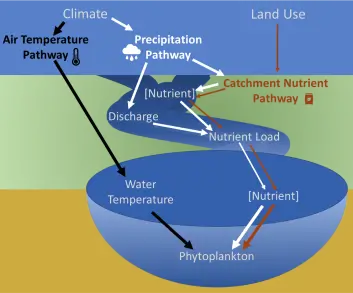Featured Data
Combined Effects of Climate & Land Use Changes on Water Quality of Lake Sunapee (NH, USA) for the Last 31 Years: Integrating Data Packages from Different Sources
January 1, 2021
Susanne Grossman-Clarke
Citation
Description
The EDI data packages featured here were applied to the General Lake Model (GLM) v.2.1.8, coupled with Aquatic EcoDynamics (AED, Hipsey et al., 2019) to simulate water quality of Lake Sunapee (NH, USA) over the last 31 years. The GLM is a one‐dimensional hydrodynamic model, while AED is a lake ecosystem model. This study was carried out by Nicole Ward and recently published in the journal Water Resources Research (Ward et al. 2020a). Nicole is a PhD student at Virginia Tech’s Department of Biological Sciences with the Carey lab that specializes in freshwater ecosystem sciences.

Lake Sunapee is an oligothrophic, i.e. nutrient-limited lake. Oligotrophic lakes in the northeastern United States are more sensitive to air temperature and precipitation changes than lakes in the same region that have higher productivity (McCullough et al., 2019). Using a complex simulation model of the lake ecosystem in conjunction with observational data allows one to understand and separate the respective contributions of otherwise complex interactions of land use and climate change that affect a lake’s water quality. Land use changes lead to unintended phosphorus and nitrogen input to streams. Climatic changes in temperature and precipitation alter watersheds’ stream flow volume and discharge of nutrients into lakes, causing lake water conditions and thereby water quality change over time. Phytoplankton concentrations, specifically the differential responses of maximum versus median chlorophyll‐a to air temperature and nutrient loads are a measure of lake water quality.
The study drew on a variety of data for model calibration and evaluation. Many of the data are published in the EDI data repository and include contributions from the Lake Sunapee Protective Association (LSPA), a member of the Global Lake Ecological Observatory Network (GLEON) and the Volunteer Lake Assessment Program (VLAP) of the NH Department of Environmental Services. The data include:
- Daily observed stream inflow temperature, volume & nutrient concentrations (Ewing et al. 2020).
- Lake Sunapee parameter set and driver files for the GLM AED (Ward et al. 2020b).
- Daily values for water temperature and dissolved oxygen for model calibration (Richardson et al. 2020).
- Meteorological data, water temperature depth profile, epilimnetic dissolved oxygen concentration from a monitoring buoy (LSPA et al. 2018).
- Summer water samples of NH lakes collected by volunteers (Steiner and Titus 2017).
- Surface pelagic total nitrogen concentrations (Cottingham 2020).
- Hourly weather data at the buoy site from NLDAS-2 (Xia et al. 2012).

In Nicole’s words “This study was only possible because of the availability of these diverse datasets.. Being able to easily access these data on EDI’s website and other data resources enabled me to focus on figuring out how to best use each dataset to achieve our research goals. Full, clear, and complete metadata was also really important. When you are using someone else’s data, having detailed descriptions about what each column in the datatable means helps you make sure you are using the data appropriately. As I’ve gotten more familiar with the format and layout of EDI datasets, it makes it even easier to quickly understand new datasets, because I know exactly where to look for the information I need!”

References
Cottingham, K. L. (2020). Surface pelagic total nitrogen concentrations in Lake Sunapee, USA 2009 to 2012. Environmental data initiative. https://doi.org/10.6073/pasta/57282aff9a884449864399012e36abf2.
Ewing H. A., Weathers K. C., & Steele, B. G. (2020). High resolution stream temperature, pressure, and estimated depth from transducers in six streams in the Lake Sunapee watershed, New Hampshire, USA 2010–2014. Environmental Data Initiative. https://doi.org/10.6073/pasta/12a18d9d178b17d2ac333930f3efca9f.
LSPA, Steele, B., & Weathers, K. C. (2018). Lake Sunapee high frequency weather data measured on buoy—2007–2017. Environmental Data Initiative. https://doi.org/10.6073/pasta/175cfde22aaeee7349285d2c9fd298d9.
McCullough, I. M., Cheruvelil, K. S., Collins, S. M., & Soranno, P. A. (2019). Geographic patterns of the climate sensitivity of lakes. Ecological Applications, 29, e01836. https://doi.org/10.1002/eap.1836.
NH Department of Environmental Services (NHDES) Watershed Management Bureau Biology Section: Volunteer Lake Assessment Program (VLAP) Environmental Monitoring data 1995–2014. Environmental data initiative. https://doi.org/ 10.6073/pasta/1df3238af71108db248f667b9561023d.
Richardson, D. C., Carey, C. C., Weathers, K. C., Bruesewitz, D. A., LSPA, & Steele, B. (2020). High frequency meteorological, drift‐corrected dissolved oxygen, and thermistor temperature data—Lake Sunapee Buoy, NH, USA, 2007–2013. Environmental Data Initiative. https://doi.org/10.6073/pasta/846a36bf6fd704e508511e5f8a2ab3b5.
Steiner, S. and M. Titus. 2017. NH Department of Environmental Services (NHDES) Watershed Management Bureau Biology Section: Volunteer Lake Assessment Program (VLAP) Environmental Monitoring data, 1995-2014 ver 1. Environmental Data Initiative. https://doi.org/10.6073/pasta/1df3238af71108db248f667b9561023d.
Ward, N. K., Steele, B. G., Weathers, K.C., Cottingham, K. L., Ewing, H. A.,Hanson, P. C., & Carey, C. C. (2020a). Differential responses of maximum versus median chlorophyll‐a to air temperature and nutrient loads in an oligotrophic lake over 31 years. Water Resources Research, 56, e2020WR027296. https://doi.org/10.1029/2020WR027296.
Ward, N. K. Steele, B., Carey, C. C., & Hanson, P. C. (2020b). Lake Sunapee parameter set and driver files for the General Lake Model Aquatic EcoDynamics (GLM AED). Environmental Data Initiative. https://doi.org/10.6073/pasta/681f48dcc63bb43655de685891f414e6.
Xia et al. (2012), (U.S. Public Domain, public access available at disc.gsfc. nasa.gov/), MRLC (2018), (U.S. Public Domain, public access available at mrlc.gov/), CSRC (2002) (no license information provided, public access available at granit.unh.edu/).